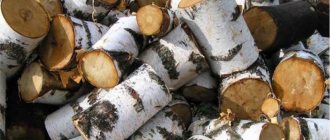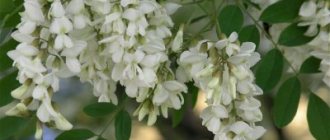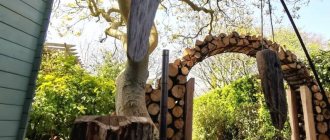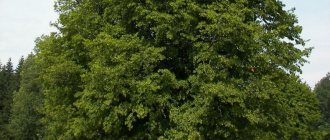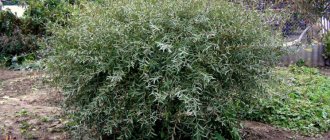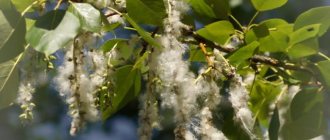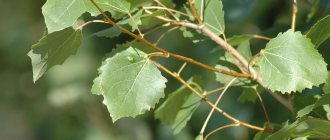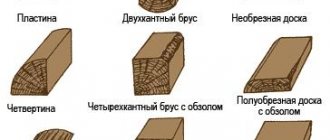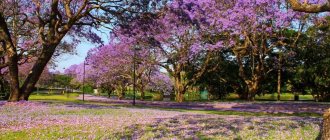Despite the fact that aspen is very famous in temperate climates, people often confuse it with other trees, most often with poplar. Knowing the differences between aspen, it is not very easy to recognize it among other trees, especially for novice gardeners.
In addition, aspen is incredibly resilient; eradicating an uninvited guest from a garden plot becomes a real problem.
Aspen is the closest relative of poplar. Translated from Latin into Russian, aspen means “trembling poplar.” And indeed, when the wind blows, the entire aspen tree begins to tremble from top to bottom.
How does this happen? This question, as well as the question of how to find aspen among other poplar trees, will be answered below.
Botanical description
Common aspen (Populus tremula L.) is a deciduous tree. Height: 25-30, up to 35 m, diameter: 50-100 cm. The root of the common aspen is powerful, located deep, forming root shoots.
The trunk is columnar. The crown is ovoid or broadly cylindrical. The bark of common aspen is smooth; in older trees it has cracks closer to the roots. Color: light green, greenish-olive, greenish-gray, dark gray at the root in old trees. Young branches are not pubescent. Wood: white, with a green tint.
The buds are small, pointed, sticky, initially hairy, then bare. Color: brownish.
The leaves of common aspen are alternate, large, glabrous, rounded at the base, with pinnate venation. On long branches they are rounded or triangular-ellipsoidal, coarsely cut; on short branches they are rounded-triangular, short-pointed, serrated, sometimes with sparse silky hairs. Length: 3-7 cm, for coppice shoots - up to 15 cm. Petioles are long, flattened laterally in the upper part.
Common aspen is a dioecious plant. Flower buds are large, ovoid. The flowers are small, inconspicuous, collected in dangling furry earrings. Men's are reddish, women's are thinner, greenish. Length of earrings of common aspen: 4-15 cm, thickness: 2 cm.
The fruit is a very small capsule. The seeds are equipped with a tuft of white fluff. Black color.
Common aspen blooms before the leaves bloom, in March-May. The seeds ripen in 35 days and are dispersed by the wind. Leaves appear 20 days after flowering.
Reproduction of common aspen: seeds, root suckers.
What does an aspen tree look like?
From a distance, aspen may look like an ordinary birch, because it also has a light trunk, mostly grayish or light green.
The bark of younger trees, as a rule, is much smoother, and with age it acquires numerous cracks running upward from the root zone.
- The leaves of this tree are quite large, rounded, jagged, bronze green in color, and the petioles are flattened in the middle and oblong.
- Over the life cycle of a tree, leaves tend to change their shape from oblong in youth to rounder in old age.
In autumn, the foliage takes on a bright golden color. The aspen stretches upward with its crown, dense branches grow to the sides. Due to the specific structure of the petiole, the foliage begins to sway even from the slightest breath of wind.
Where aspen grows: growing areas
This tree is quite common in Russia: aspen can be found in the central zone of the country, Arkhangelsk, Vologda regions, Transbaikalia, and the middle Volga region. The favorite place of growth is considered to be forest and forest-steppe zones, banks of reservoirs, swamps, and ravines.
The tree is not very picky about the choice of soil. Once in any soil, the aspen will eventually spread in different directions, where a young aspen forest will form. What trees grow in the aspen forest? These can be pine, spruce or birch. You can find one or more aspens among a birch grove, in an alder forest and next to oak trees.
The aspen tree can be heard from afar with the noise of its trembling leaves
It is more difficult to grow in the steppe, and aspen shoots root shoots up to 40 m in different directions from the mother tree. After a few years of such capture, an aspen clump will form in the steppe, which will occupy many hectares over several decades.
After a fire, aspen trees recover very quickly thanks to their deep root system.
This interesting representative of the willow family is widespread not only in Russia, it has also invaded the forests of Europe, the Mongolian and Kazakh steppes, and the Korean Peninsula.
Characteristics of trees of the aspen genus
The average life of a tree is about 100 years, during which time it manages to grow up to 30-40 meters. The wood has a whitish tint, and at the site of the log house it even gives off a blue tint (there is a version that it was because of this blue color that aspen got its name).
- The tree is considered a fast-growing tree; at the beginning of its life it can grow 40-80 cm every year.
- Aspen is highly valued by woodworkers because it is a soft wood that is quite easy to work with and cut.
Another advantage is aspen’s resistance to moisture. Wood can be preserved in water for a long time, and when dried it does not crack.
Moreover, when wet, it becomes even more amenable to processing and carving; this can be done even with a well-sharpened knife.
Why is he shaking?
With a slight wind, the foliage of a tree begins to oscillate, resembling trembling in nature. People have the expression “trembling like an aspen leaf.” The fact is that the leaf plate is flat, and the cuttings on which the leaf is located are flat.
Unlike other plants, the leaf and stem are not flexible and begin to vibrate when the wind blows lightly. Therefore, it seems that the tree is trembling.
An adult tree often rots; the process begins gradually and as it grows, the trunk becomes hollow inside. Therefore, during strong winds, damaged trees often break.
Interesting facts about the tree
Aspen is used not only in medicine; it is necessary to note some facts:
- Aspen bark is a favorite delicacy of deer, elk and hares, so if the tree is grown at home, it is necessary to protect the trunk from unexpected guests.
- In the old days, when fermenting cabbage, several aspen branches were placed in a container. This additive improves the taste and eliminates harmful microbes that appear during cabbage fermentation.
- Wood is used for processing log houses in wells, since the material does not decompose or rot.
- Artificial vanillin was made from rotten wood.
- Due to its antibacterial and hemostatic properties, antipyretics were previously made from aspen material.
- Ash from aspen was used as an organic fertilizer because, unlike other types of wood, it contains a large list of useful substances.
Aspen is a tree that is distinguished by its external characteristics. To compare varieties, it is necessary to study not only the photo and description, but also the natural appearance of the plant.
Wood is valued not only for its appearance. The bark and leaves of the crop have medicinal properties; an equally valuable factor is the wood, which is used in construction. Therefore, the crop is often planted in plots to decorate and improve the quality of the soil.
The difference between aspen and poplar
It is not difficult to find signs of how poplar differs from aspen. There are several reliable signs:
- Branches from both trees with dormant buds broken in early spring should be placed in a glass of water. The poplar will be the first to start growing and spread its sticky leaves, while the aspen will wake up later and its leaves will not have such a pronounced shine.
- The aspen blooms first, followed by the poplar. Moreover, only the poplar will give abundant fluff.
- The structure of leaf petioles in the two species is different: aspen petioles are long and easily tied into a knot, while poplar petioles are short.
- Aspen branches are more fragile and break easily from force, while poplar branches are more likely to bend than break.
- If you compare the leaves, they have a lot in common, but there are also differences - the shape of the poplar leaf is more elongated and pointed.
Differences in bark
Birch is the only tree in the world with white bark. It is difficult to confuse it with other plants.
Due to growing conditions, it can acquire a greenish, yellowish, and in rare cases red and even black tint.
Another difference is the presence of black lentils and raised cracks.
Aspen bark is green-gray and can fade to beige or blue.
At the bottom it is usually rough. May have deep cracks. In the middle part of the trunk, it is smooth and has a green tint.
When splitting aspen firewood, the bark comes off in large pieces. Birch bark is thin and soft. Its top layer is birch bark, consisting of many thin layers. This is the most significant difference.
Spreading
Aspen grows in large quantities on the border between the tundra and forest zones, as well as in the forest-steppe. The plant prefers to grow along the banks of reservoirs, on forest edges, in ravines, in mountainous and swampy areas, and can rise to the very top border of the forest zone. Being an unpretentious wild-growing form, it takes root more readily in well-moistened soils, although it does not die under conditions of steppe drought. The lack of light is critical, which causes the crown to quickly fade.
Aspen is not capricious and freely coexists with coniferous and various deciduous species. In the free steppe zone, one tree quickly forms an entire colony of root shoots, and the distance from the mother plant to the shoots can reach 30-40 m. Such groves are not afraid of fires, since the roots remaining deep in the ground in the spring give rise to a young population that grows at a speed of up to 1 m per year in height.
In the southern regions, where there is enough light and moisture, aspen competes with other slow-growing species: oak and conifers. Especially often its dense thickets can be found in areas where industrial logging took place. Therefore, replacement species are planted as soon as possible to prevent the uncontrolled spread of aspen trees.
Aspen grows over a vast territory of the temperate climate zone from Europe to China, in Kazakhstan and Mongolia, is found in Korea, and grows everywhere in Russia. In the Chukotka Autonomous Okrug, the plant is included in the Red Book.
Climatic conditions
In order for aspen to feel good, climatic conditions must be met. You can find aspen in mixed deciduous forests. However, there are often isolated forest plantations consisting only of aspen trees. The tree usually grows in open areas. If a massive tree is located nearby, the aspen dies.
Pines and spruces often appear among the aspens. In the first years, aspen acts as a kind of cover for conifers. But gradually, when the trees become taller than the aspen, they shade it, and the tree loses its external characteristics and dies.
Aspen propagation: features
We are interested in the details of the propagation process of a tree called aspen.
Its seeds have a very low level of endurance, and become unsuitable for use after just a few days, from the moment they fall out of the boxes.
An important condition for successful germination is a sufficient level of moisture in the soil.
Only once on such soil do the seeds have a chance to grow. If the ground is covered with leaves, the grain will simply get stuck halfway and die.
Such conditions do not make every area of soil suitable.
Therefore, young animals grown from seeds are not such a common sight. They are found in places where the soil has been plowed, loosened and sufficiently moistened. There are simply none in the forests.
How aspen creates forests: propagation by root shoots
When you have the opportunity to visit an aspen forest, take a close look at the already mature specimens of this wood.
Reproduction of aspen in forests occurs, in the overwhelming majority, with the help of long systems of roots and shoots scattered throughout the plant’s habitat.
Somewhere nearby, a young shoot will definitely appear, very similar to a poplar. The height of the shoot is approximately up to the knee for an adult.
And how did they get here:
- To answer this question, you need to take a shovel and carefully clear the ground around the young tree.
- You'll see something interesting. A long and thick cable-like root of an adult aspen will run through the ground. It is from this that this green aspen tree originates.
- Such a root can grow and stretch quite long distances in any direction.
- If you really want to, you can dig out the path from the root to its tree and see how many offspring it has produced.
- Young aspen trees are shoots that originate from the roots of the mother tree; they are also called root shoots.
For your information. Just one such root can produce more than ten or more young trees. Their arrangement resembles balls on a string, arranged at significant intervals.
A new sprout appears at a distance of more than 35 m from the mother tree. At such a distance, it can be difficult to find and correlate a specific tree and sprout, especially in a forest, with its root routes.
Propagation by seeds in this case has very low efficiency.
Methods of using aspen
Aspen has a wide range of uses. The harvested material is stored for a long time without reducing its characteristics.
Medicinal properties
All parts of aspen can be used for medical purposes. Leaves, bark, roots, buds and even inflorescences. However, you should not self-medicate, as improper use of the material can be harmful.
Among the beneficial properties of wood it is necessary to note:
| Part of the plant used and method of application | Indications |
| Bark decoction | For the treatment of cough. Has a thinning effect and removes mucus. |
| Decoction of young twigs | Helps reduce fever and is often used as an additional treatment during colds. |
| Leaf tincture | Used as an anti-inflammatory agent. Widely used in the treatment of hemorrhoids. Tea made from the leaves reduces inflammation in the respiratory area. |
| Bark tincture | It has a choleretic and anti-inflammatory effect. Used to treat urinary tract problems. A weak infusion of the bark is used to boost immunity after suffering viral infections. |
| Compresses from a decoction of young shoots | Effective for bleeding, relieve inflammation and have a binding effect. |
| Baths with leaves, roots and tree inflorescences | This mixture is used to treat skin wounds and ulcers. Recommended for general strengthening of the body. |
Aspen is used for cosmetic purposes. Solutions and tinctures relieve inflammation when treating acne. Masks with aspen extract have a tightening and tonic effect and fight age-related changes in the skin.
When to collect material
You can purchase the necessary material at the pharmacy. However, the bark is often collected independently, especially if aspen stands grow nearby. In order for the material to be useful, it must be collected correctly.
Methods of using aspen tree bark.
To do this, the following features must be taken into account:
- Foliage is harvested in mid-May. During this period, the leaves contain all the necessary substances.
- The bark must be collected at the end of April. To do this, use a sharp knife, which is used to carefully cut off the bark from trees no older than 10 years old.
- The inflorescences are collected in May during the flowering period. During this period, young shoots that contain tannins are also collected.
All collected materials must be washed in running water and dried. The prepared material must be stored in a warm, dry place.
For cultivating the soil
Aspen improves the soil on which it grows. The roots penetrate deep into the soil and saturate it with oxygen. The tree regularly sheds branches and leaves, which subsequently rot and become organic fertilizer.
It should also be noted that the roots of the tree loosen the soil and retain moisture. Aspen is often planted along ravines; such plantings hold the soil together and prevent it from crumbling. After fires you can often find aspen plantations. They are planted to restore the soil after exposure to high temperatures.
In construction
Mature plants are used for construction purposes. They are used to make boards that are widely used in construction work.
Features of aspen wood building material:
- The tree is highly resistant to moisture. Therefore, it can be used for external finishing work.
- The material is soft and is often used in furniture production.
- The wood does not crack, so it will last for a long period without reducing the quality of its appearance.
- Affordable price. Unlike oak and ash, aspen is much cheaper.
There is an opinion that wood is not very strong; it is most often used for small structures. For example, baths, furniture or finishing of wells. In fact, everything is a little more complicated: when dried, aspen material undergoes significant deformation and becomes unsuitable for use for industrial purposes.
When properly processed, aspen lumber becomes hard and durable after long-term or chamber drying.
Moreover, its weight and density are significantly lower than other wood. Previously, shingles (a type of wooden tile) were made from aspen, which covered the roofs of buildings and the domes of temples. The service life of such roofing material was about 150 years. Unlike other types of wood, aspen does not have a pattern.
In landscape design
Aspen is a tree (photos, descriptions and examples of use are presented by some designers) that looks very impressive in the landscape. Therefore, it is often used for decorations for filming and photo shoots. Also, the tree will decorate any area. The tree is especially valuable in the autumn.
The advantages of aspen are not only in its attractive appearance, but also in the following practical properties:
- Aspen areas protect from winds, so they are often planted in parks and around fields. Also, the use of aspen can protect against snow drifts.
- In large cities, aspen trees are used to purify the air. Their leaves tend to consume exhaust gases that appear when vehicles move.
- The tree rarely catches fire in the summer.
Aspen trees are undemanding to care and will decorate any area.
Benefit
A tree such as aspen, whose leaves help provide shade in the summer and brighten the area during autumn days, is valued primarily as timber. Since this tree grows quickly, it is used for landscaping.
In winter, hares and moose feed on the bark of this woody plant, and this helps them survive frosts.
Application of aspen wood
- Very durable products can be made from aspen, so dishes made from this species are considered to be of high quality.
- Wood burns poorly, which makes it an excellent raw material for the production of matches.
- In the household, it is used as an excellent additive in pet food, as it contains many useful substances. Feeder yeast from aspen stimulates the growth of animals and increases their productivity.
- Quite light wood, which is also moisture resistant, makes very beautiful buildings or furniture. Previously, log houses for wells or cellars for storage were made from it.
- In the spring, the catkins of this tree attract bees, which begin to collect pollen from them, at the same time fertilizing the plant itself. Insects make bee bread from pollen, and propolis from glue collected from unopened buds.
- Viable aspen is widely used for landscaping areas, because it does not require special care or conditions.
- The bark of young trees is food for many animals in winter. Deer, hares or moose are not at all against such a meal.
Contraindications
There are no serious restrictions on the use of aspen. The only thing is that aspen decoction is not advisable for people who have any digestive system disorders.
In addition, sometimes it happens that a person has an individual intolerance to this decoction. Therefore, before being treated with traditional medicine, it is better to consult a specialist.
So, we hope we have answered all your questions about aspen. Learn, explore and enjoy nature!
What aspen looks like - photo gallery
Aspen undergrowth is attractive for walking. To get to know this tree better, we have selected a number of photographs. Now you can be sure that you will not confuse this tree with any other.
Photo of aspen tree
Aspen leaf photo
What does aspen look like in winter?
Winter aspen forest Lonely aspen in winter clothing In the photo, the aspen tree looks fabulous in winter
Tree care
Proper tree care involves choosing the right place to plant it and watering it. The plant is planted in the ground in the form of seedlings or seeds. Seedlings are transplanted in the spring to give them time to take root in a new location. Aspen is not picky and quickly takes root. It is planted away from residential structures, since due to the early appearance of rot in the trunk, the tree can easily collapse. The fluff during flowering causes an allergic reaction in some people.
Aspen seeds
The distance between each planting hole must be at least 2 meters. Otherwise, instead of trees, the seedlings will grow into a single bush. The recesses themselves should be shallow.
It is important to have an additional drainage layer of 8-10 cm from crushed stone or pebbles. With its help, the soil will retain moisture and create favorable conditions for aspen growth.
For the full development of seedlings, it is worth ensuring:
- correct choice of soil. Fresh, fertile and well-draining loamy or sandy loam soil is suitable;
- regular watering of the plant. Artificial cultivation of aspen requires periodic soil moisture. During dry periods, watering should be plentiful. The tree cannot tolerate dry soil;
- feeding It is applied at the stage of transplanting seedlings or planting them in the ground. Subsequent application of fertilizers is not required due to the powerful and well-developed root system. More often, mullein is used in a ratio of 1 kg per 20 liters of water and superphosphate - 20 g per the same amount of liquid;
- pruning thick branches from February to April. Young branches can be cut all year round;
- cutting down mature trees over 50 years old. Young shoots quickly appear around their stumps.
The soil at the site where the seedlings are planted needs additional loosening and weeding. Proper care will accelerate the growth of young aspen and its healthy development in the future.
Characteristics and features of wood
Aspen is often called quaking poplar. A common type of tree, which is often found not only in parks, but also in forests. The plant is valued not only for its decorative qualities, but also as a building material.
Description
Aspen is a tree (photos, descriptions and characteristics can be found in many reference books) that has the following features:
- tree height can reach up to 15 m;
- an adult plant has a columnar crown;
- bark with a slight gray tint, smooth to the touch without dark spots;
- the leaves are small, wavy at the edges, matte green.
The plant has a long life span (up to 100 years). And if conditions are favorable, the tree can live longer.
Features of the tree
Culture is very common.
However, like all plants, it has its own individual characteristics:
- in trees over 15 years old, deep cracks appear in the bark;
- young leaves are colored light green. However, in mid-summer they become dark and only then begin to turn yellow;
- the root system is highly developed, and root shoots penetrate deep into the soil in search of water;
- The flowering period of the crop is in May.
In order for the tree to develop well, during planting it is necessary to maintain a distance between seedlings of at least 4 m. Otherwise, the plant will experience a lack of nutrients.
Interesting facts about aspen
It is believed that the name aspen itself comes from the word “blue”. Our ancestors also noticed that the place where a tree was cut turns blue. In ancient times this was given magical significance. However, modern scientists have found that this is a chemical reaction to the interaction of tannins contained in wood with the metal of an ax or saw. The interesting texture of wood is highly valued by craftsmen, who use wood as a material to create objects for various purposes.
The Latin name of aspen - Populus tremula - is translated into Russian as “trembling man”. This is what they say about a frozen or frightened person - he trembles like an aspen leaf. There is a widespread belief that the property of a tree to flutter its leaves even in calm weather is due to the fact that the traitor of Jesus Christ, Judas Iscariot, once hanged himself on it. And, according to superstition, with every memory of this terrible event, the aspen tree begins to tremble in fear.
However, as scientists have found out, this tree never grew in Palestine: neither in biblical times, nor in our days.
Experts explain the property of leaves to flutter simply. It's all about the structure of the leaf. Anyone who has looked closely at what an aspen tree looks like has noticed that its leaves are relatively wide and dense to the touch, while the petioles are very long and flexible. That's why they can't keep their leaves straight. This simple fact explains the sensitivity of aspen to any air movement.
To believe or not to believe in mysterious forces is everyone’s personal choice. However, it cannot be denied that this tree is beautiful at any time: during the time of flowering of catkins, and in the summer, when the rustling of leaves can be heard even in the calm, and during the autumn leaf fall. To observe how the tree looks throughout the year, it is worth planting an aspen near your entrance or home.
Basic properties of aspen
Aspen has been loved since ancient times for its beneficial properties. Not only wood is valuable for making furniture and baths, but also bark. In times of famine, aspen bast was ground into flour and baked into bread. The branches of the lower tier are also used in our time to prevent spoilage of sauerkraut during preparation. This cabbage can be stored without problems until late spring. The crushed bark is added to food by foresters and hunters to relieve fatigue.
Medicinal properties
To understand why aspen is considered healing, consider its chemical composition. Tree bark contains glucose, sucrose, and fructose. In addition, it contains a lot of aromatic acids, tannins, higher fatty acids, as well as salicin and populin.
Aspen bark is used for medicinal purposes
The buds are rich in raffinose, fructose, the same aromatic acids, tannins, and triglycerides of phenolcarboxylic acids.
The leaves are also a storehouse of organic acids, carbohydrates, vitamin C, carotene, anthocyanins, flavonoids and some other substances.
Based on such a rich composition, the antimicrobial, anti-inflammatory, antitussive, choleretic and anthelmintic properties of aspen parts were revealed. Infusions of buds, leaves and bark, and aqueous extracts of tree bark are used.
Properties of wood
The wood is homogeneous, so it does not cause problems either during cutting or processing. Abrasion resistance has been noted. Aspen wood is dense (490 kg/m³) and moderately hard (1.86 Brinell).
The wood structure is straight-grained and light. Summer hats are made from thin aspen shavings by weaving. The use of shavings is not limited to hats. It is dyed with aniline dyes to make flowers. It is known to use pressed shavings for packaging containers.
When working with aspen wood, it is noticeable that it splits easily and cracks quite a bit.
Aspen carving
Aspen is widely used: they make dishes, aspen ploughshares were used for roofing domes, making matches, woodcarvers also love to work with this wood.
Aspen wood in construction
Aspen is also processed into boards. For construction purposes, mature trees that have reached the age of 40-45 years are suitable. The wood is light and has virtually no pattern. It has several features:
- high resistance to high air humidity and precipitation;
- soft but uniform structure;
- long service life - it does not crack over time;
- low cost.
Aspen wood is an unstable species and is therefore not suitable for residential construction. However, it is popular in the manufacture of wells, baths and other buildings, as well as in the production of matches.
In landscape design
It is important to understand where the aspen tree grows in order to use it in landscape design. It prefers well-lit areas and crowds out other plant varieties. Representatives of this species grow quickly, forming up to 3 m of young growth in the first years. They are not afraid of heat and frost, and quickly recover after winter. However, they have one problem - the center of the trunk often rots. With age, trees become loose and fragile, so when growing them under cultural conditions, it is important to check their condition annually.
Aspen is popular in landscape design not only for decorative purposes, but also due to its beneficial properties:
- aspen plantings provide good protection from the wind;
- on the banks of reservoirs, wood prevents soil from sliding;
- in large populated areas it is used for landscaping and air purification;
- rarely catches fire.
Aspen is widespread everywhere. In most cases, it forms separate plantings, displacing less strong trees. In nature, it reproduces by seeds, but it is more convenient to purchase and plant seedlings. These are strong trees with a wide root system, unpretentious to growing conditions. They are popular in construction and landscaping, and continue to be used in the preparation of folk medicines.
Aspen for soil cultivation
Aspen improves the properties of the soil on which it grows. In autumn, abundant leaf fall can be observed, and trees also shed small branches. Over the winter, this material undergoes a series of chemical transformations and becomes a useful fertilizer. In addition, the root system has its own characteristics. The roots are shallow, but spread over a considerable distance. In the soil in which the aspen grew, multi-level passages remain, which are used by more demanding crops. The cultivation of this species is practiced to improve clayey and insufficiently fertile soils with low moisture conductivity.
Aspen has a powerful root system and often displaces other plants.

